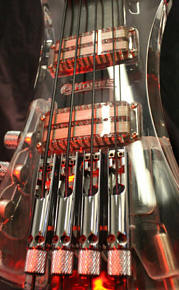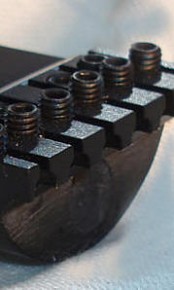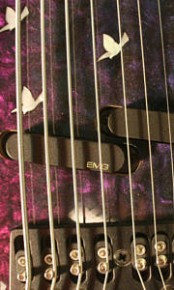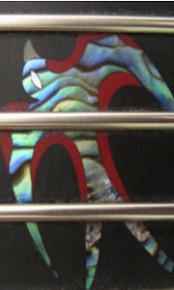A series of Jim Reilly’s interviews with players, fans, and the people behind the scenes of the Chapman Stick. These interviews can be heard regularly on CFBX radio, 92.5 FM in Kamloops, B.C. Canada.
Graphite: A Stick Story
An Interview with Stephen Mosher of Moses Graphite Inc.
January 5, 2002
The hub of the Stick world is an overwhelmingly busy place. Phones ring constantly, deliveries come and go, staff constantly work on electronics, wood, office duties. Time is of little relevance. Two or three day’s work gets crammed, somehow, into one.
A little less than a year ago, I was at Stick Enterprises doing some research for an ongoing project. For me, spending time at Stick Enterprises can only be compared to a kid getting to visit Santa’s workshop.
I addition to the regular din, while I was there the Chapman’s were in the middle of some major renovations. Adding another workshop, more space that seemed to fill before it was even created. On top of all that, for four days, yours truly took over a fair chunk of the main table with newspaper clippings, photos, papers of all sorts, my mini-disc recorder-a real mess. Before me lay a modest chunk of Stick history: early articles, concert reviews, magazine clippings. Just past that however lay something different.
On a couch in an adjoining room lay a small, neat stack of Stick blanks, ten or twelve in all. A Stick blank is exactly that, just the Stick, no components or hardware, no frets. These were no ordinary Sticks though. These were the first batch of what would become the new “structural graphite, continuous strand carbon fiber, long-scale Sticks.”
As I buried myself in Stick past, every now and then I would glance up, look at those new instruments and marvel at how odd it felt. In one instant I was back in 1970 with Emmett and Barney Kessel playing at Shelly’s Manne Hole. In the next instant I was staring at The Stick’s future.
In this installment of Talking Sticks I’m going to be talking to a Stick. Well, all right, I can’t think of any crafty way around this so I’ll come clean. I’m actually talking to the guy who sub-manufactures the graphite Stick through-neck beam structures.
Stephen Mosher is the president, founder and force behind Moses Graphite Inc. Moses makes graphite necks and all sorts of components for different instrument manufacturers as well as a couple of their own complete instruments.
In addition to building necks for the newly re-released Gibson Steinberger guitars and replacement necks for Fender instruments, Moses Graphite can now boast that it holds the contract to make the new structural graphite, continuous strand carbon fiber, long-scale Stick blanks.
Jim Reilly: What got you started in this?
Steve Mosher: I basically started out as a Southern California beach kid. I got involved in making surfboards pretty early on. Then I made hydrofoil belly boards, doing things a little differently. As I look back on it, I was playing with plastics long ago. I was playing my Fender bass with various people around Eugene Ore., and I just got bored with it. So I started screwing around, trying to make myself a neck that I would like to play. And it got out of hand.
JR: Where did the idea to use the graphite come from?
SM: I was quite familiar with boat building. I sailed boats a lot when I was a kid. Carbon fiber started coming in for use in stiffening up masts. I looked at it and decided to nix the wood. I was interested with the material and just started using it because it was interesting.
JR: When did it turn into a business?
SM: I incorporated and did my first NAMM show in 1989. But I didn’t really begin production in any meaningful way until early 1994. I was told at the time that, as is normal in most of these businesses, you’ve got to hang in for five years. Nothing really is going to happen, unless it’s an unusual situation, for five years.
And in truth, those guys where just about right. If you take a look at what we were doing in 1999, that’s basically when things began to turn. We started making all kinds of stuff, from working with Tacoma Guitar up in Washington, to making this wild Chrysalis Guitar to working with the SoloEtte Travel Guitar. It took a while to develop. I was at this basically in 1980 and the business didn’t really start to happen until 1999.
If you look at Taylor Guitars, which is a real success story, those guys were slugging it out in a small shop in San Diego for 20 years before they made the turn. It’s not terribly unusual. One would love to have overnight success and some businesses do but that’s more rare than common.
JR: The overnight success takes seven years.
SM: Exactly. And sometimes business look successful when they’re not and sometimes businesses don’t look successful and they are. There’s sleeper business. Businesses that don’t advertise a lot could be highly successful and nobody would know it.
JR: How did the connection with Emmett come about?
SM: I knew Emmett was making Sticks out of polycarbonate and so in about 1989 or ’90 we got together, went to his place, sat down and talked things over. He revisited the situation about a year and a quarter ago and said, “Let’s try this.” He was ready to rock. He sent me up a Stick or two, I had a look at it and said, “Yea, this is how to do it.”
It’s designed differently internally than some of my other products. Each product is designed to accommodate different sonic and technical parameters. We designed the first ones, he brought them to the NAMM show last year, they weren’t on the market yet but he was just playing it and loving it and showing people.
We finally got down to brass tacks around March and provided him with instruments later in the year. Now he’s on line with the 8/10-string version. We will soon have the master for the 12 and are working on getting ready so he will be able to introduce that.
JR: Take me through the process of a creating these Sticks.
SM: Emmett had a parameter for finished weight. He also stated that he felt there was no way that a graphite version was going to appreciably alter the sound. Based upon his fairly extensive use of various woods and the polycarbonate, he found almost no differences in the sound quality, probably because it’s a tapping instrument, metal on metal. I designed the initial Stick structure so it had stiffness where it was appropriate. We could get lightness without worrying about sonic parameters so much, no tone chambers or this or that little trick or gadget. He needed solid footing to attach various things. And he needed durability; to know that if somebody throws it across the stage, it’s durable. As with all our neck products, we integrated linear tow, which means continuous fiber in the same direction as the string tension.
JR: Does that add stiffness?
SM: That’s for stiffness and for carrying energy from one end to the other with a continuous strand of a very conductive material. Just like you’d want to have continuous, linear fiber in wood to do the same job. We took all this into account and made it work just fine from the first one. We made some changes based upon where Emmett was going to fasten parts and other things he had to do afterward. And then he said, “I can hear a subtle difference in tone, a smoothness and solidity.”
JR: Did you approach The Stick differently? The neck is the instrument; there is no resonating body. Did you approach it like a large guitar neck or did you have a different angle since you’re constructing the entire through-neck beam out of graphite?
SM: I approached it differently because Emmett said it was not going to affect the sound that much. It freed me up to think differently.
(*Note: Emmett was concerned with creating a structure that enabled precise setup. Moses’s unique production methods and construction materials translated into great tone from the outset. These new Sticks have the rich highs you would expect from a graphite instrument balanced very nicely with smooth, solid lows.)
SM: On guitars and basses, the further away from the body, the smaller the beam gets. From the point of view of wanting stability, one wouldn’t want that. You’d want something more like The Stick: a standard even cross section. In terms of a standard product, a tube is very stiff. When you hack it off and it becomes a half circle it’s not near as stiff. A guitar neck or a bass neck is less than half a circle. So you’ve got this thing tapering, getting smaller and smaller. The further out the more the strings have the ability to pull and bend the neck, which presents its own peculiarities. That’s why you get warped necks. Now The Stick doesn’t do that, it’s a standard cross section. That makes it, from that point of view, a lot easier.
I could say a lot about The Stick, in terms of the innovations that Emmett has come up with. I think he’s a genius for having taken a component system of elements and figuring out the simplest way of producing something that has such gigantic possibilities. You get these ‘gadget guitars,’ certainly a player could do a lot on a guitar, but they stick all these little switches and knobs and all these fancy finishes that look all sparkly and this and that and the other thing, and what do guys do? They slam a bunch of chords and then play single note solos.
Then you take The Stick. This thing is an even cross section, no radius, the body is on the same plane as the neck. He’s got components that just pop together afterwards-the damn truss rod goes in from the outside-a component pickup system that does the whole thing-including the knob right on it. All these things pop together. You take this thing and you look at it. From the manufacturing point of view it’s simplistic but it’s elegantly simplistic and look what people can do with it. It’s scary. It’s a whole other way of looking at things. In essence I had started out looking at The Stick as this separate thing but it turned out to have some tonal qualities. I’m very sensitive about not wanting our necks being perceived as being bright and brittle sounding.
JR: That’s the knock against graphite. When people talk about it in negative terms, that’s what I keep coming up with every time, that it’s a brittle, sterile sound.
SM: Yea, and you know that’s unfortunate. The feedback we get from the players we sell our necks to and one of the reasons why Ned Steinberger suggested to Gibson that they have us make their necks rather than anybody else was because our necks aren’t sterile and brittle. They just plain old aren’t. But you’d have to hear that for yourself.
JR: How’s your shop set up?
SM: Well I’ll tell you, a year ago I expanded because I’ve been able to see an accelerating trend toward acceptance and normalcy being created in alternative materials, including composites. Also, the vintage thing is burning itself out. All that’s left is cheaper and cheaper, what I call the race to the bottom. They’ve pretty well hit rock bottom prices now and so that race has been run. From there things start getting more expensive again or stay where the are and creep towards more expensive. But after everybody has a cheap instrument, how many more cheap instruments do they need? Sales will start dropping and that’s when something else will come in.
There are two basic tricks in the music industry. One is vintage and one is high tech. The industry flip flops back and forth. They milk one as long as they can and once sales start dropping they move toward the other. Until they find a third or fourth trick, they’ll just keep going back and forth. The vintage phase has been around for quite a long time and they’ve milked it to the point of absurdity.
JR: How long do you think that’s been going on?
SM: Mid ’80s. The last vintage thing started quite a long time ago. Prior to that, the creep toward high tech was pretty short lived. Then alternate materials, including graphite composites where coming in and those alternate materials, that creep toward high tech didn’t last all that long, no more than seven years, from ’78 to ’85 at most. Part of that was marketing and part of that was having products being produced with new materials not living up to their expectations. There were things said about materials including graphite composite necks that were great in theory but were not showing to be true in fact. There were claims being made that weren’t exactly accurate.
JR: Was the problem with the production of the instruments or was it the material that was being used?
SM: The production. There were theories being thrown out, aerospace style theories being thrown out, and being applied to musical instrument necks in particular that were great theories and still are great theories. Some of which eventually panned out some of which didn’t. Things were being said like, “the necks being produce in that early ’80s period were absolutely stable.” And they weren’t. “They don’t need a truss rod.” And they did. There were also claims like, “Sound just like wood.” Well, it’s sort of in the ears of the beholder but to most players ears, they didn’t sound just like wood.
JR: I see a trend now, I’m thinking about the Rainsong Guitars in particular which are a complete graphite instrument, and they’re not claiming to sound like wood. They’re claiming to have a richer, fuller tone. So maybe the whole thing about trying to sound like wood isn’t the way to go. Have a unique rich sound on its own.
SM: Some people are going to want that sound and some aren’t. But then some people choose Gibson guitars and some people choose Strats because of the differences between sound and feel and look. Not everything is for everybody. There’s a known standard and the standard is wood. If you try to work it up to the standard, you’ll never get better than the standard. The standard is the standard, it’s what you’re comparing it against. You could put all this work into it and what do you do, you finally get as good as what was already there.
JR: That’s an interesting shift in perspectives. I’m a Stick player. A lot of people play the instrument to sound like a guitar and a bass player at the same time but Emmett himself has said that a guitar and a bass player will always be able to sound more like a guitar and a bass player than you. The whole thing is to come up with something unique.
SM: Yea, so from my point of view, you just have to acknowledge that you’re creating your own sound. You may judge it to be ‘as good as’ or ‘better.’ But if I say, “It’s just like ebony,” all I’ve done is stated that ebony is the standard and I’m a copycat. Does that place me in a position of being dominant or new or exciting? No. I’m just trying to get ‘as good as.’ And I don’t want to be there. I don’t want to spend my whole life trying to be as good as something else if I feel like I can be better, in my own way, and help move traditions in a direction.
So with all that happening and all that changing, a year ago we moved to a new facility and kept the other one as an R and D place. We’re a business down in the industrial zone and we’ve got 6,000 feet. I bought a bunch of new tools. Let’s say, “We got fancy” and set up a nice production line. I’ve got a capacity, which I’ve not met yet, of 1,600 to 1,800 necks per month along with our other products. We sent our first orders to Gibson. We’re doing the new Gibson Steinberger necks. They’re re-introducing the American made Gibson Steinbergers now. We’re doing that and we’re doing a lot of other things. Things keep expanding. We were certified by Fender earlier in the year. Fender gave us a very good agreement that helped with those replacement neck situations.
JR: Just to wrap up, from the Stick side, I know Emmett is very happy with the instruments and he speaks very highly of the work you do. He considers you to be at the top of the heap.
SM: I appreciate that, he’s a luminary and he’s been at it a lot longer than I have.
JR: His words to me are: “These graphite Stick models represent the state of the art. They’re the best instruments I’ve ever made.”
SM: I’ll just say this, even though I’m approaching 50, I’m younger than some of these guys. I got into this business kind of late at 30. When I first got into it, I had been just a working musician. I had my heroes and idols, guys who would just make your jaw drop whenever you heard their name or their records. I now have an opportunity where I’m friends with a lot of these people. I just look back and go, “Wow, what happened here?” To the same degree, I feel like it’s an honor when I look and go, “I can hang with Emmett.” I was just blown away and in awe of The Stick ever since… And all of a sudden, here I am helping him make an instrument that is a pretty fine instrument.
Could life be any better? No way. It’s amazing what happens sometimes. I’m still just a guy who lives out in the forest. I live on five acres, out of town, in the forest with deer and stuff wandering around. And yet I’m doing some pretty high tech stuff. I get the best of both worlds. And I get hang with some of these people.
JR: So life is good?
SM: Yup.
Find out more about Moses Graphite on the web at http://mosesgraphite.com/
Jim Reilly can be reached at play_stick@canada.com.










